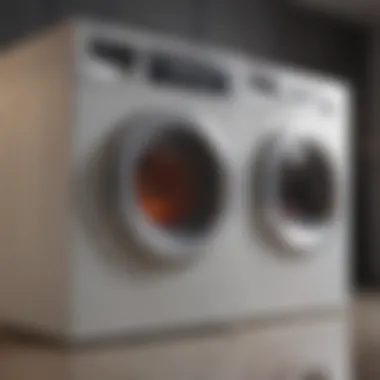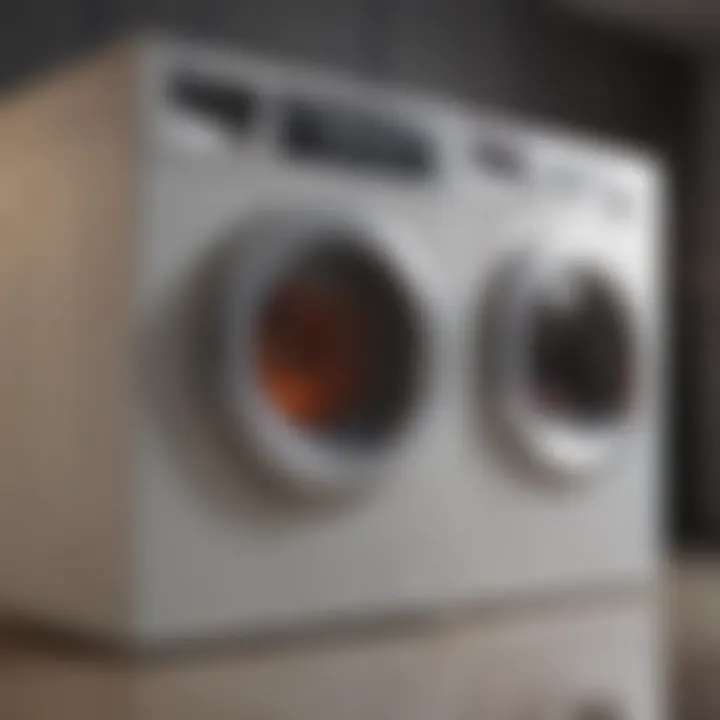How to Separate Laundry for Best Results


Intro
Laundry day, for many, feels like a chore laden with potential mishaps. Picture this: you throw a red shirt in with your whites and find your entire load has transformed into a pinkish hue. Sound familiar? This is just one example of why separating laundry properly is not just a good practice but a necessity for keeping your garments in prime condition.
In this guide, we’ll delve deep into the art of laundry separation, exploring various approaches tailored for different fabric types, colors, and specific washing needs. The goal here isn’t just to save your clothes from future disasters, but also to enhance your washing machine's performance, ultimately elevating your overall laundry experience.
Why Proper Laundry Separation Matters
Avoiding Damage: Clothes are not made equal. Different materials require distinct care and washing methods. Separating them helps you maintain fabric integrity over time.
Preventing Color Bleeding: As mentioned earlier, meeting colors and whites in the wash can be disastrous. By sorting laundry based on color, you protect the vibrancy of your favorite outfits.
Boosting Machine Efficiency: A well-sorted load can lead to a more efficient wash. Clothes that need similar wash cycles and temperatures tend to come out cleaner and drier.
"Sorting laundry isn’t just advisable; it’s essential for fabric longevity and maintaining the mood in your wardrobe."
In the upcoming sections, we’ll breakdown practical techniques for sorting through your washing. From identifying fabric types to recognizing color compatibility, every aspect is covered. This guide is designed to help not just the seasoned laundress but also the novice, ensuring optimal results.
Next, let’s dive into practical sorting strategies.
Understanding Laundry Basics
To grasp the full scope of laundry management, it's crucial to delve into the fundamentals. At first glance, laundry might seem as straightforward as tossing clothes into a machine, but there's a tangible art and science behind it. Understanding the basics lays the groundwork for successful laundry practices, allowing you to not only enhance your laundry efficiency but also extend the lifespan of your garments. It's about setting the stage so that your clothes come out looking their best, every time.
The Importance of Separating Laundry
Separating laundry is not just a simple chore; it’s an essential practice that significantly impacts the overall success of your laundry routine. Why is this separation so vital? Well, first and foremost, it mitigates the risk of color bleeding. Imagine bright colors running into your pristine white shirt, turning your once-stylish outfit into an accidental tie-dye mess. Furthermore, this practice helps in maintaining fabric integrity. Different fabrics require different care – washing delicate materials like silk with rougher fabrics can lead to damage. By understanding and applying the separation of garments based on color and fabric types, you’re essentially safeguarding your favorites from unnecessary wear and tear.
In addition, properly separated laundry optimizes washing machine performance. When you group items wisely, you create a more effective clean. For instance, a load filled with items of similar weight and fabric type can move freely in the machine, ensuring that every piece gets the needed attention without leaving behind detergent residue or soil.
In short, separating laundry not only keeps your clothes in better condition but also saves time and energy in the long run.
Common Laundry Myths
Misconceptions run rampant in the world of laundry, and these myths can lead to erroneous practices that may wreak havoc on your wardrobe. One prevalent myth is that all clothes can be washed together if the water temperature is set to cold. While cold washing is beneficial for many garments, it doesn't cover all bases. For instance, washing heavy towels with lighter fabrics can not only lead to inefficient cleaning but also increase the odds of stretching or pulling on the delicate items.
Another frequent belief is that all detergents are created equal. However, various brands offer different formulations – some are tailored for specific fabrics or washing machines. It's essential to choose the right detergent suitable for your laundry load. Not to mention, using the correct amount of detergent is vital; too much can leave residue behind, while too little might not clean effectively.
Here are some common myths to debunk:
- Myth 1: You can toss any fabric in the washer without worry.
- Myth 2: All detergents work the same.
- Myth 3: High heat is always better for sanitizing clothes.
- Myth 4: You don’t need to sort laundry; cold water solves everything.
Understanding these myths helps in correcting practices and ensures your laundry rituals yield the best possible results. Overall, separating laundry and shaking off these common myths fosters a smarter approach to garment care.
Categorizing Your Laundry
Properly categorizing laundry is more than just a time-saving technique; it's the foundation for maintaining the quality and lifespan of your garments. Understanding how to effectively separate your laundry based on key criteria enhances the overall washing experience. This method not only safeguards clothing from unwanted wear and tear but also promotes optimized cleaning, ensuring that each fabric gets the attention it deserves. By implementing thoughtful categorization, housekeepers can dodge common laundry headaches like color bleeds and shrunken sweaters.
As they say, "A stitch in time saves nine," and applying this idiom to laundry can mean the difference between a fresh smell and faded, damaged fabrics.
Sorting by Color


Lights
When it comes to sorting, lights include pastel shades and whites which are essential for a complete load. The characteristic of these garments is their susceptibility to grime and markings from darker clothes. Washing lights separately ensures that colors remain bright and garments are less likely to become dull over time. Given that lighter fabrics can show stains more easily, it's prudent to wash them apart and use detergent designed to enhance brightness. An advantage of this approach is that it minimizes the risk of color transfer, which can be a tragic reality for your favorite pastel top.
Darks
Darks, on the other hand, encompass rich tones like navy, burgundy, and charcoal. This category is vital because darker fabrics are prone to releasing dye in warmer washes. The key feature of washing darks together is preventing color bleeding into lighter items, which can turn a bright white into a muddy blush. Darks are a popular choice for those who wish to maintain their wardrobe's integrity during the laundry process. A notable advantage of washing these together is the ability to utilize a detergent specifically designed for dark clothing. The one downside here might be that if mixed with some unstable colors, you could still experience some unwanted surprises.
Whites
Whites are often the backbone of a well-structured wardrobe, providing a clean canvas for various styles. The main characteristic of whites is their need for specific care to maintain brightness and avoid dinginess. Washing whites together allows for the use of bleach or other whitening agents without risking colored items' hues. This is particularly beneficial for maintaining items like dress shirts and linens. A unique aspect of whites is their ability to become stained easily, and a disadvantage lies in the potential for discoloration if treated recklessly. Thus, their separate washing is advisable for those who want to keep their whites looking pristine.
Sorting by Fabric Type
Delicates
Sorting delicates, such as silk and lace, is crucial for their longevity. These fabrics are known for their fragility, making them candidates for a gentler wash cycle. The key feature of delicates is their delicate fibers, which can easily tear during harsher washes. By categorizing delicates, you ensure they receive the softest treatment possible with specific detergents designed for these materials. One downside is that frequent handwashing or gentle cycles can be a bit tedious, but the trade-off is worth the worried looks during laundry day.
Heavy Fabrics
Heavy fabrics like denim and canvas require their own sorting strategy due to their weight and absorbency. They tend to release lint and absorb other colors easily. The primary characteristic of heavy fabrics is their need for a robust washing cycle that can handle the weight, which ultimately helps maintain their structure and durability. The advantage here is that heavy items can usually be washed more harshly than delicates, contributing to longer-lasting wear. One must remain cautious, though—sometimes heavy laundry can lead to slower drying times, which can be a hassle.
Activewear
Activewear is another essential category, often made from synthetic materials that grip sweat and odors. They require special attention to cleaning methods, as traditional detergents can sometimes degrade these materials. The significant attribute of activewear is its moisture-wicking properties, which can be impacted if not treated correctly. The advantage of sorting this type of fabric is that it preserves those high-performance qualities. The downside is an increased need for specialized detergents that may not always be readily available at home.
Sorting by Washing Instructions
Cold Wash Only
Cold wash only items, usually indicated on labels, are suitable for fabrics sensitive to heat, such as certain synthetics and vintage clothes. The advantage of this method is it saves energy and reduces the risk of damaging the garment. However, the downside is that not all stains are effectively removed with cold water. Adjusting temperature is essential to ensuring the cleanest results, especially for heavily soiled items.
Tumble Dry Safe
Tumble dry safe clothing can often manage heat but requires proper monitoring. The key element is to understand that this instruction reflects the fabric's endurance. One must ensure to balance the drying time, as fragile items might still suffer damage if left in the dryer too long. The benefit is ease—the ability to toss clothes in without stress. A drawback lies in the potential for shrinking or overstretching if mixed care isn't observed.
Hand Wash
Hand wash instructions indicate a more careful approach, typically needed for fragile pieces. This method allows one to take great care in handling clothing within soapy water, ultimately preserving elusive fabric qualities. The big plus here is a gentle cleanse that can save garments from serious wear. The downside is the time it takes—hand washing isn’t efficient if you're running behind on laundry day. Still, the focus on care can result in clothes looking fresher for longer.
"Keeping your laundry separated is like putting the puzzle pieces together for a clearer picture of your clothing care routine. It ensures each piece gets the proper treatment it needs."
Understanding the nuances of laundry categorization equips homeowners and housewives alike to create a sustainable, efficient, and productive laundry routine.
Common Laundry Challenges
Laundry may seem simple on the surface, but navigating its complexities reveals several common challenges that can undermine a well-organized and efficient washing routine. Whether you’re a seasoned pro or just starting to sort your laundry, understanding these problems can help you maintain the longevity of your clothes and the effectiveness of your washing process. Addressing issues like color bleeding, fabric damage, and shrinkage risks is essential. These concerns not only affect the appearance of garments but can also lead to costly replacements if not managed properly.
Dealing with Color Bleeding
One of the biggest headaches in laundry is color bleeding. This happens when dyes from colored fabrics transfer to lighter items during washing, leaving unsightly stains that often can't be removed. To prevent this, one should follow a few crucial steps:
- Sort Carefully: Always separate whites from colors. This is your first line of defense against unexpected color mingling.
- Pre-Wash Test: Fear not to test new garments! Dampen a small, inconspicuous area with water and blot with a white cloth. If the color transfers, it’s likely to bleed in the wash.
- Cold Water Wash: Lower water temperatures reduce the chances of dyes escaping from fabrics.


"Proper care in sorting clothes can save both money and frustration in the long run."
Managing Fabric Damage
Fabric damage can come in various forms, such as pilling, tearing, and fading. This can be caused by washing items that should be treated separately or using inappropriate settings on the washing machine. To reduce the risk of damage:
- Check Labels: Always read garment care labels to understand the specific washing methods recommended.
- Use a Gentle Cycle: For delicate fabrics, select a gentler wash cycle. This minimizes agitation and reduces friction that can lead to wear and tear.
- Mesh Laundry Bags: Use these for delicate items such as lingerie or activewear. They provide a protective barrier during the wash cycle, reducing the chance of damage from other garments.
Understanding Shrinkage Risks
Shrinkage is a risk that many overlook, particularly for fabrics like cotton and wool. It often results from heat during washing or drying, leading to a wardrobe full of misfits. To manage shrinkage:
- Wash in Cold Water: Just as with color bleeding, cold water helps maintain garment size.
- Air Dry When Possible: Instead of using a dryer, hang dried clothes whenever feasible. This will help retain their natural shape and size.
- Pre-Shrunk Fabrics: Consider purchasing pre-shrunk items when buying new clothes, but keep in mind that even these can shrink further without care.
Understanding these common laundry challenges is vital for safeguarding your laundry investment and maintaining clothing in top condition. Being mindful about how you sort, wash, and dry your clothes will pay dividends in the long run.
Best Practices for Laundry Separation
Effectively separating laundry presents a myriad of benefits that some might underestimate. It goes beyond just picking out darks from lights; it ensures the colors stay vibrant, prevents mishaps that may lead to fabric damage, and optimizes washing machine performance for longer life. Following best practices for laundry separation not only saves your favorite pieces but also helps in maintaining that fresh-out-of-the-store feel.
Developing a Systematic Approach
A systematic approach to laundry separation can feel a bit like organizing a library—each garment belongs in its rightful place. Here’s why it matters:
- Avoid Color Transfer: When you toss everything into the wash without a second thought, you're inviting color bleeding. Dark colors can easily bleed onto lighter items if left unchecked.
- Ideal Washing Conditions: Fabrics behave differently under various conditions. A delicate lace blouse won't fare well with denim in a vigorous wash cycle. Categorizing can make sure each type receives the care it needs.
- Time Efficiency: Picture pulling out a heavy blanket from a load full of delicates! Having a clear plan means no digging through heaps of mixed laundry, making your laundry day smoother.
To create this systematic approach, consider setting up a sorting routine. Perhaps every time you undress, toss your items into a designated bin according to their category. Over time, you’ll develop an intuitive system, quickly identifying which pieces go where.
Using Appropriate Laundry Baskets
Choosing the right laundry baskets might seem trivial, but it plays a major role in how you separate laundry. Here are elements to consider:
- Designate Different Baskets: One for lights, one for darks, and another for delicates, can streamline your process. This way, you prevent mixing and can simply grab the appropriate basket when it’s wash time.
- Use Clear Labels: If you’re the type who often forgets which basket holds what, clear labels can be a lifesaver. They make it easy for everyone in the household to pitch in during laundry.
- Consider Size and Space: Assess how much laundry you typically have. A small basket might work for a single person, but for families, larger bins can keep you from making countless trips to and from the laundry room.
In summary, employing a systematic approach and using the right baskets works hand in hand. It creates a more efficient routine that reduces stress. After all, no one wants to deal with the laundry fiasco where whites become tinted greys or delicate fabrics become mere memories. Adopt these practices today, and you might be surprised at how freeing an organized laundry system can be!
"The more organized your laundry is, the more time you have for the things you love."
Through these best practices, you’ll not only maintain the quality of your garments but also elevate your laundry experience. Remember, a little preparation goes a long way in avoiding future headaches.
Eco-Friendly Practices in Laundry Separation
As we strive to carve out a greener path in our daily lives, managing laundry provides us with an excellent opportunity to embrace eco-friendly practices. Proper separation of laundry is not just about avoiding color bleeding or fabric damage, but it's also about making mindful choices that benefit the environment. The way we wash our clothes can significantly impact water usage, energy consumption, and overall sustainability. By adopting eco-friendly practices, we can minimize waste, conserve resources, and extend the life of our favorite garments.
The Role of Fabric Care in Sustainability
To understand how fabric care correlates with sustainability, one must recognize how different materials react under various laundry conditions. Natural fibers like cotton and linen typically require less maintenance than synthetic fibers, but they still need proper care to ensure longevity. When we prioritize careful handling of our garments, we reduce the need for replacements, which ultimately conserves resources.
- Washing at Lower Temperatures: Using cold water when washing clothes not only saves energy but also prevents shrinkage and fading. Many detergents are now designed to work effectively in cold water, making this an easy adjustment.
- Drying Methods: Instead of relying solely on the dryer, consider line drying. This method uses no electricity and gives clothes a fresh smell from natural air. However, some fragile fabrics might require flat or gentle drying.
- Repair over Replace: A good practice in maintaining fabrics sustainably is focusing on repairs. Rather than tossing out a torn shirt or frayed hem, mend it. This simple action extends the life of the garment and lessens the overall environmental footprint.
"Caring for your fabrics wisely is one step closer to a sustainable lifestyle."


Choosing Eco-Friendly Detergents
When it comes to laundry, not all detergents are created equal. Traditional chemical-laden detergents can be harmful, both to the environment and the fabrics themselves. Choosing eco-friendly detergents can make a huge difference in promoting a sustainable laundry routine.
- Plant-Based Ingredients: Opt for detergents that use plant-based rather than petroleum-based ingredients. They are generally safer for the environment and less likely to irritate sensitive skin.
- Biodegradability: Select detergents labeled as biodegradable. This means they will break down more naturally in the environment without accumulating harmful chemicals.
- Concentrated Formulas: Using concentrated detergents not only requires fewer packaging materials but also reduces the volume of water needed for product delivery. This results in a two-for-one win: less waste and lower environmental impact.
By paying keen attention to how we sort and wash our clothes, we not only care for our garments better but also contribute positively to our ecosystem. Embracing these eco-friendly practices in laundry separation is yet another way to be a conscientious homeowner.
Special Considerations for Different Garments
When it comes to laundry, not all clothes are created equal. Recognizing this fact is a cornerstone for maintaining the longevity and appearance of your garments. Each type of fabric comes with its own unique care requirements, and failing to account for these can lead to unfortunate damage and an unnecessary need for replacements. Understanding these specific considerations can save you time and money, and it ensures your clothes look their absolute best.
Care for Denim and Heavy Materials
Denim may represent casual comfort, but it also comes with its own quirks during washing. When you’re dealing with denim, it’s essential to remember that darker jeans can bleed color. This is especially important when washing them with lighter fabrics, as a mishap here could ruin your favorite white blouse. To mitigate risk, wash denim inside-out. This practice reduces friction and helps preserve the color.
Additionally, using cold water can help prevent shrinkage and fading, which are common concerns with heavy fabrics. Denim generally requires a longer rinse cycle to ensure any detergent residue is washed away.
Lastly, avoid overloading the washing machine when dealing with heavy materials. Just as a car performs better on the road without excessive weight, your washer works more efficiently with the right load size.
Handling Wool and Cashmere
Wool and cashmere are prized for their softness and warmth, but they are delicate materials that need extra care. Unlike standard cotton apparel, these fabrics can shrink and lose their shape if not treated properly.
Always opt for hand washing these fabrics in cold water, or use a specialized wool cycle on your washing machine, if available. Stick to liquid wool detergents, as they tend to be gentler than other types. After washing, avoid wringing them out, which can lead to stretching. Instead, lay the garment flat on a clean, dry towel and roll it up. This method helps absorb excess water while keeping the fabric's shape intact.
Another golden rule is to avoid hanging wool or cashmere garments to dry, as this will surely stretch them out. Instead, reshape them while they’re still damp and let them dry flat.
Athletic Gear Maintenance
Athletic gear has come to signify a lifestyle, but it requires its own set of care instructions to maintain its form and functionality. Many sports fabrics are designed to wick moisture away, and over time, they can accumulate odors and stains if not laundered correctly.
For best results, wash athletic wear in cold water with a gentle detergent. Higher temperatures can break down the elasticity and moisture-wicking properties of the fabric, which is the opposite of what you want.
A common mistake is tossing fabric softeners into the wash. These can create a film on the fabric that inhibits its breathability. Less is more when it comes to detergent—too much can make your workout clothes smell worse. Additionally, air-dry athletic gear instead of using the dryer to extend the lifespan.
In sum, giving your clothes the specific attention they need allows them to serve you longer and better. Understanding these nuances will not only elevate your laundry routine but help maintain an organized closet. Remember, taking the time to care for your unique garments pays off immensely in the long run.
"An ounce of prevention is worth a pound of cure."
Caring for specific materials might seem tedious, but with a little mindfulness, you can keep your wardrobe looking fresh, vibrant, and in tip-top shape.
Ending: Elevating Your Laundry Routine
When it comes to laundry, the end goal isn't just clean clothes; it's about instilling a routine that enhances both the longevity of your garments and the efficiency of your efforts. This guide sheds light on the crucial art of separating laundry properly, revealing its profound impact on the overall washing experience.
The Long-Term Benefits of Proper Separation
Proper separation serves as your first line of defense against unforeseen laundry frustrations. Think about it—no one wants a favorite white shirt tinged with pink from a rogue red sock. Color mixing isn’t the only enemy; mishandling fabric types can lead to irreparable damage. When you create a system based on color, fabric type, and washing instructions, you naturally extend the lifecycle of your clothes. This can save you money in the long run and keeps your wardrobe looking fresh and intact.
Imagine your favorite pair of jeans losing its shape or your delicate blouse turning into a rag due to improper care. Separating your laundry not only prevents these occurrences but also helps in maintaining the brilliance and texture of various fabrics, preserving their original state as much as possible. You end up with clothes that last longer, look better, and often require less frequent replacement.
Creating a Sustainable Laundry Environment
Laundry practices can contribute quite significantly to environmental impact, and proper separation plays a role here too. Integrating sustainable habits into your laundry routine helps reduce water usage and chemical runoff, fostering a healthier planet. Using eco-friendly detergents in conjunction with properly sorted laundry minimizes the risk of harsh chemicals harming fabrics and waterways alike.
Furthermore, by washing clothes with similar fabric types, you optimize your machine's efficiency, thus conserving energy. Pair this with correct drying methods—hanging clothes to air dry when possible or setting shorter cycles for similar textiles—and you have a win-win scenario.
In essence, elevating your laundry routine isn't about complicating the process; it's about creating a thoughtful approach that aligns with both care for your garments and consideration for the environment.
Remember, thoughtful separation isn't just a chore; it's an investment in the longevity of your clothes and the health of our planet.
In closing, as you begin incorporating these practices into your life, you'll notice a change not only in your laundry results but also in your perspective towards home management. A solid separation strategy turns the mundane into the methodical, encouraging a lifestyle where you take pride in every garment you own.



